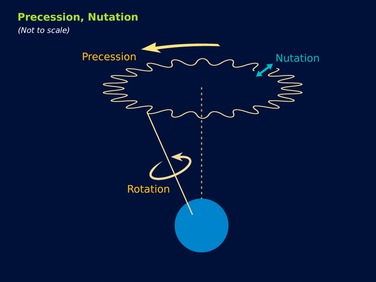Precession causes the vernal equinox (the first day of spring in the Northern Hemisphere) and all other points along the ecliptic (Earth's path as it orbits the sun) to slowly shift in the same 25,600-year cycle.
Press the S button in the Time and Date display to move time forward at 40-year intervals. Notice how precession changes the position of the North Celestial Pole.
If we used sidereal years for our calendars, the true seasons would slowly slip through the calendar months until, eventually, winter in the Northern Hemisphere would begin in July.
But since it's more convenient to keep the seasons constant, we measure the year as the length of time it takes the sun to circle the sky relative to the vernal equinox, not to an artificial date on the calendar.
If you visualize the Earth's equator as a line circling the middle of the globe and then extend this circle into space, you have what astronomers call the celestial equator. The vernal equinox occurs at the intersection of the celestial equator and the ecliptic.
The time it takes the sun to travel from vernal equinox to vernal equinox is 365 days, 5 hours, 48 minutes, and 46 seconds. This is called the tropical year.
The tropical year is a few minutes shorter than the sidereal year because as the Earth is revolving around the sun, the vernal equinox is slowly moving—precessing—westward along the ecliptic. So the time it takes the sun to return to this westward-moving equinox is a few minutes less than it takes the sun to return to the same position among the stars.
Checking the speedometer, Earth travels around the sun at an average speed of 107,000 kilometers (66,500 miles) an hour. In the 15 seconds it's taken you to read this, the Earth has moved 450 kilometers (280 miles) through space!
